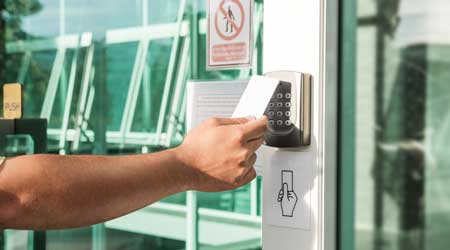 Technology such as key cards enables managers to improve security while avoiding the need for occupants to touch door hardware surfaces.
Technology such as key cards enables managers to improve security while avoiding the need for occupants to touch door hardware surfaces.Door Hardware Upgrades That Deliver Safety, Security and Health
Coronavirus considerations join the list of issues managers must weigh in specifying door hardware components
Door hardware components in institutional and commercial facilities have always been central players in ensuring the safety, security and health of occupants and visitors. And as mass shootings increase and as facilities nationwide grapple with the fallout from the coronavirus pandemic, maintenance and engineering managers must take an even closer look at their decisions when specifying door locks, closers, hinges and other key components.
By understanding advances in new-generation locks, closers, hinges and other key components and by identifying weak spots and vulnerabilities in security and safety, managers can specify door hardware more effectively and incorporate it successfully into upgrades designed to enhance security.
What’s new
Interchangeable core locks are available in a larger number of brands. They have a control key, which releases the core from the housing, and an operator key, which opens the lock. The control key is slightly longer, allowing it to trip a release in the back end of the core for core removal.
If personnel changes, lost keys or scheduled periodic replacement require re-keying to maintain security, the technicians simply replaces the lock core and distributes new matching keys without costly emergency locksmith calls. The technician then can recombinate the core and, along with a matching set of keys, store it for later use if the need arises. The same interchangeable core can be extracted and replaced in any type of lock, including bored cylindrical locks, mortise locks and padlock.
Master mechanical key systems are set up with several levels, each one opening a wider range of locks, with one master key that opens all the locks. Managers can achieve the same control and security by using proximity cards or other electro-mechanical computer-controlled systems. These systems also have a much wider range of applications, including time-of-day, day-of-week, seasonal, job description, contractor control, and rapid, no-locksmith rekeying, to name a few. This flexibility and enhanced security are among the key reasons for the rapid expansion of electro-mechanical locks.
As more door-security systems convert to electro-mechanical technology, it will be increasingly important to use generator backup with auto-transfer from the power distribution system. One proven choice is a generator fueled by natural gas that is piped in underground to provide a reliable fuel source.
Closer mounting designs also have expanded in recent years. Closer types include surface mounts, in-frame, in-header, in-floor, in-door, in-shoe, and integral-to-hinge. Automatic closers, also called door openers, are used for high-traffic, no-touch sanitary, and remote auto-close-and-lock security applications. Heavy-duty closers, which have variable backset-spring sizes and are capable of 10 million cycles, are effective choices for high-wind areas and high-traffic applications.
Managers can prevent door removal even when hinge pins are removed by having technicians install security pins in the top and bottom hinges. The technician can install the ¼- by 1-inch pin by drilling a hole through the hinge plate on the door side of the hinge. The pin is inserted into the hole, leaving it extended ¼ inch. The frame side hinge is marked, and a hole is drilled in it.
When the door is closed, the extended end of the pin inserts across the gap into the frame side hole. Now, even with the hinge pin removed, the hinge is secure, and an intruder cannot remove the door from the frame. For a few dollars and a few minutes of installation time, the cost-benefit ratio is outstanding.
The coronavirus epidemic is making its presence felt as it relates to a number door hardware products as key advances can help improve hygiene in and around facilities by eliminating cross-contamination, which occurs when an occupant has to contact the door hardware directly to pass through. In the last decade, one major supplier has seen an increase in electromechanical-product sales from 20 percent to 50 percent. Cell phone applications enable an occupant user to lock and unlock doors remotely without touching door hardware surfaces. Key fobs offer the same benefit. Motion sensor-controlled doors can open and close without contact.
Even with these advances, frequent cleaning and disinfecting of the personal door operator equipment, such as cell phones and key fobs, are important for protecting the users’ health by eliminating cross-contamination. Another low-contact solution is the proximity card. The user only has to keep the card sanitized, since the card does not contact the lock when scanning near it.
Related Topics:














